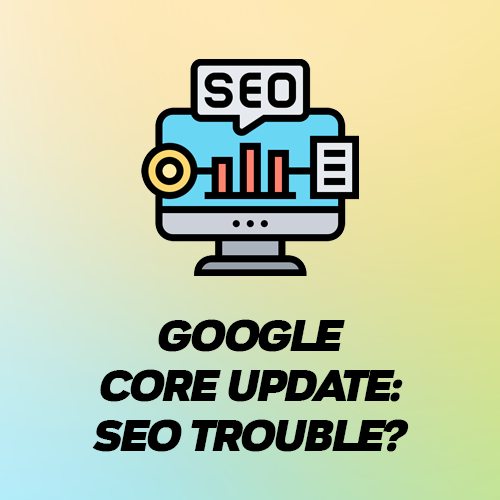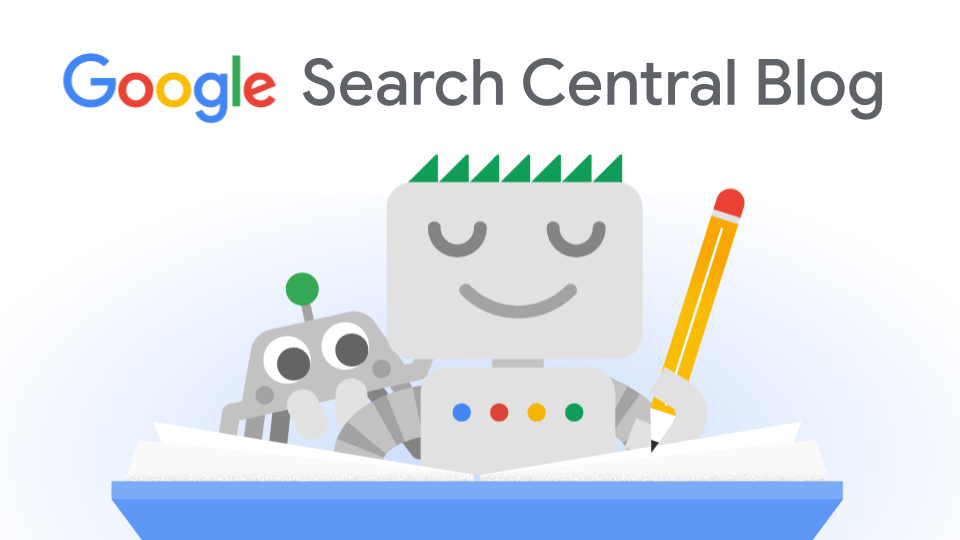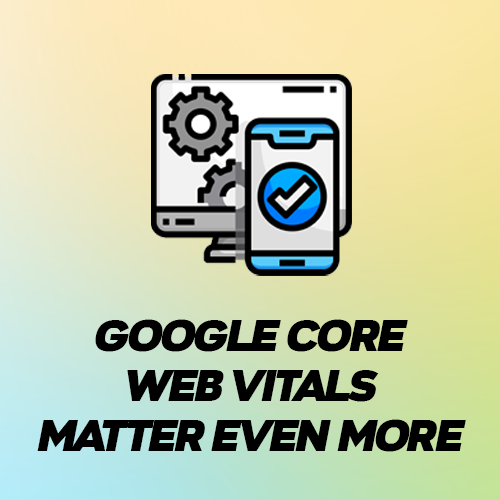Google Core Update: Trouble for SEO?

Some E-Commerce Owners are Frustrated by Google Core’s Update
It’s clear that Google’s Core Update has already affected a lot of businesses online. While the new Search Engine algorithm just began rolling out in May 2022, some e-commerce sites reported immediately falling out of the SERP rankings for important keywords, as well as seeing a drastic drop in clicks and impressions on the site. Take the following tips below as a starting point to improve your Google SERP ranking.
Click here for part I of our coverage on the Google Core Update

- Increase Posting Frequency
The most effective way to rebuild and grow your SEO, as well as your e-commerce sites online visibility, is to begin posting more frequently on your site.
Did you have a blog post rocket to the top of the Google charts two years ago? That’s great, but it won’t be enough to continue thriving following the May 2022 Google Core Update. If you are staying current and up-to-date on the major trends within your industry, Google is going to be rewarding you with a boost in page ranking!
2. Strive for Originality
On top of that, Google will now be rewarding sites that post original content. If you are reposting content from another site or using AI-generated content, Google is going to ding you. Also, if the quality of the content is basically a rambling word salad, and considered not useful for users, Google will rank that lower, as well.
Best Solution: Diversify your Traffic Generation Avenues
Aside from posting original quality content for frequently, it’s important that e-commerce business owners use the Google Core Update as a wakeup call to not rely solely on the search engine giant for their revenue!
You can begin ad campaigns with Ad360 in one click that bring visibility to the entire web, meaning you get impressions from outside Google’s display network and across all apps. On top of trying out various social media platforms, business owners can ensure that even if the Google Core Update affects their traffic from search engine’s other revenue streams and ad channels pick up the slack!
Google Core Web Vitals matter even more

Google Algorithms Control your SERP Ranking
Because of its ubiquity on the market, Google holds huge influence on your e-commerce store’s visibility and viability through your site’s SERP: “Search engine results page.” Being ranked on the first page in Google search is the aim of any successful e-commerce business, so many will research or hire experts in “Search Engine Optimization” (SEO) to do just that!
Big News: Changes to Google’s Core Algorithm?
After following the same guidelines for the past few years, Google has officially begun rolling out the next “Google Core” algorithm update. While the implications of this update will not be clear for several more weeks, its important for e-commerce businesses to be aware of how Google’s Core Update could affect the visibility of their e-commerce site.
Double-Check Your “Core Web Vital” Metrics
Core Web Vital metrics include your site’s page speed, its response to user input, and the stability of the webpage loading across different devices. While it’s early on, it appears sites with strong core vitals are immediately seeing a boost in traffic. We’ve mentioned the importance of webpage speed here, so make sure you get a comprehensive website audit to check these core vitals!
While anecdotal, some online business owners reported seeing a 25% spike in traffic following the Google Core Update. It appears the strong fundamentals of their “Core Web Vitals” played a role in their boosted visibility online.
Also, it is clear that sites with original content are being boosted. If you have AI-generated content, or have boosted the work of someone else, Google now has software that spots the duplication of content, resulting in a lower SERP for your e-commerce store.

News Updates on Google Search Algorithm
Since Ad360 is devoted to helping e-commerce businesses successfully advertise their quality products online, we are paying close attention to the rollout of Google’s Core Update for Google Search. Stay tuned for new developments and insights on this story!
Google Retail Search Released to the Public

Searching but Not Finding: the Phenomena of Search Abandonment
Picture the common scenario, where, frustrated by the lack of results on their search, a customer leaves your site without buying anything.
That simple snafu costs ecommerce retailers over $300 billion a year.
Amazing, right? Such a simple hitch in the process can bleed billions of dollars in the ecommerce industry. Even retail giants like Macy’s and Ikea suffer from search abandonment, so you are not alone!
Luckily enough, Google recently released its Google Retail Search to the general public, bringing the power of Google’s search engine to all online retailers. Read below how this new Google tool can help increase your sales on Shopify!
Why Google’s Retail Search is a Win for E-Commerce
A recent poll discovered that 94% of US customers abandon an online shopping session due to irrelevant search results. Imagine that a shopper types in, “comfy winter sweater” to your search bar… they probably won’t get very precise results!
However, with Google Retail Search, backing software would be able to link the customer’s buying intent, no matter how general in their search, to specific products available in your store. Most ecommerce sites have search bars that, if the specific product name is typed, can provide the result quickly for users.
But what about all the potential customers who don’t know your brand’s products yet? Navigating around to find the item that fits their match can be a chore they refuse to do, especially when ecommerce giants may be able to provide better search matches.
How Google Retail Search Helps Increase Sales on Shopify
Google Retail Search will help boost your Shopify sales in a few ways:
1. Advanced Query Understanding
This function provides high-quality search results for even the broadest searches. If you sell footwear, and someone types in, “shoes for the beach,” instead of telling them, “What can’t find that specific product, can you refine your search?” It will bring up a list of all your products that fit the context.
2. Semantic Search
You will be able to better gauge “customer intent” to match them with the best-fitting products on site.
3. Personalized Results
Google Retail Search will also factor in each user’s previous searches through their search engine optimizing their experience and providing them tailor-made search results, even on your Shopify site! All of this is done automatically for your ecommerce business.
4. State-of-the-art Customer Data Security
While the search results provided by Google Retail Search are personalized, Google implements “strong access controls” to ensure your customer data is anonymized and protected
Conclusion: Google Retail Search is Worth a Trial
As a certified Google partner, Ad360 knows the power of leveraging Google’s incredible search engine, ad platform, and analytics technology. If you want any advice or help implement Google Retail Search to your ecommerce site, contact us at Ad360 today! We provide a free website review, along with a free trial. That way, we can test your search query and see what comes up 😊 Less search abandonment could increase sales on Shopify, so don’t hesitate to check out Google Retail Search!
The End of Google Universal Analytics

Introduction: Google Announces they are sunsetting Universal Analytics
E-Commerce business owners beware! The previous generation of Google Analytics – Universal Analytics or UA in short – will soon be sunset, Google announced today. What is still the most widespread version of Google Analytics used in e-commerce websites will become unusable starting July 1, 2023. This means that it’s only a matter of time before everyone is using Google Analytics 4 (aka GA4). GA4, which was first introduced in July 2019, comes with many changes. The data analysis is more granular, user-friendly, and up-to-date on privacy controls. We’ll get into some of that below while to explain the significance of this announcement!
Before we do, it is important to note that, for existing business owners, historical data cannot be transferred over from Google Universal Analytics to Google Analytics 4. However, there is no need to get worked up – universal analytics will be sunset only next year, meaning business owners can learn to leverage the perks of Google Analytics 4 alongside their Universal analytics account in the meantime. That means as you “learn the ropes” to leverage GA4, you can continue using your existing Google Universal Analytics account.
That being said, business owners will want to migrate sooner rather than later to Google Analytics 4 – learn about some of the key feature updates below!
Integration with All Device Across Web & Mobile
First, it’s important to note that Google Analytics 4 will streamline and consolidate user data from both web and mobile platforms. Google’s new system will empower business owners to track user data across each device they use, painting a more complete picture of user behavior.
Business owners used to need a Firebase and Universal analytics account to share data, but GA4 brings all the customer data from mobile and web under one roof. Multiple data streams – all from different devices and web apps – can be viewed together seamlessly.
No More Cookies
We know they sound cute, but user cookies are a key weakness in user privacy. At this point, they are basically archaic, and tightening user privacy laws will make cookie tracking technology obsolete within the next few years.
Google Analytics 4 gets out in front of this issue by preparing for this “cookieless world.” All data, while connected to a web ID for the user, is completely anonymized. Powerful software fills in the gaps when you are modeling user behavior, meaning businesses can still predict customer behavior effectively while not jeopardizing their personal data.
If you rely on third-party data to collect user info, it is time to get acquainted with Google Analytics 4. It will allow you to continue gathering valuable user data without endangering their privacy or coming across as an “invasive” online company.
Everything is an Event
While Google Universal Analytics struggled to patch together a coherent picture of user behavior, Google Analytics 4 treats every user action as an “event,” creating a constellation of user data that clearly tells a story through their online behavior.
Before, business owners had to essentially infer parts of user data because the data simply was not streamlined or categorized together. You had to pick through different data streams, identify the same user, and manually put together a picture of the user’s online behavior. With Google Analytics 4, every single event is tracked and stored in the same system.
For example, imagine a potential customer first checked out your site on a Facebook mobile ad. Then, after getting home from work, they visited your online website from their computer, where they “signed up” for an account and e-mail alerts. After that, later in the evening while browsing on their phone, they receive an email with a “special deal” and decide to download your business’s app to formally place their first order. Google analytics 4 would trace that entire series of decisions, recording each as a unique “event” that illustrates how users are discovering and utilizing your online business!
Furthermore, these user events are organized to provide advanced analysis reports and helpful data visualizations that far exceed the power of Google Universal Analytics. Purchase probabilities, funnel reports, custom audience segment overlap, visualizations of user activity down to the “per minute” detail are just some of the features business owners can now leverage with the release of Google Analytics 4.
Conclusion: Ad360 Can Help Businesses Migrate to GA4 & Fully Leverage New Features
Clients of Ad360 will receive support transferring data and migrating to the new Google Analytics 4 interface. While the new Google Analytics interface does look different, remember it serves the same purpose: helping online businesses increase sales and thrive in the e-commerce ecosystem.
This is a significant step forward in data privacy and user data analysis, and we are so excited to be at the forefront of the upcoming Google analytics revolution! If you want support when learning how to best leverage the new features of Google Analytics 4, reach out for a free call with Ad360 today!
Google Ad Secrets for your Shopify Store

Introduction – Being “Seen” on Google Search
With 8.5 billion searches executed a day, Google Ads are a primary promotional tool for Shopify owners. However, it’s not as easy as “1, 2 3,” to suddenly begin boosting traffic to your store and converting sales with Google ads. In fact, a large majority of Shopify store owners express a certain level of discontent when trying to optimize their Google ads efforts.
One even said, “It’s at the point where I would pay someone to do my Google Ad campaigns if they know what they are doing.”
… Well guess what! This blog provides the 360° view on how to organize Google ad campaigns to maximized sales. There is a way to compete with retail giants with Google ads, so long as you are razor sharp in establishing your target audience, network, and keyword phrases. Read below to learn how to approach your Google ad campaigns for increased sales and Shopify success!
Basics of Setting up Google Ad Campaigns
To start, let’s establish that Google Shopping ads reach over a billion users, and 75% of shoppers regularly use Google products when browsing online. While starting a Google Ad campaign does cost money upfront, it is a worthy investment if you can establish a strong marketing strategy beforehand.
First, you need to establish a location and network – what region are you trying to reach with your ads? The Entire USA? A region like the West Coast? A single state, city, or neighborhood? Precision here will save you money, so make sure you know exactly who you want to reach
From there, Google has multiple networks to run ads on, but we’ll focus on search engine ads and Google Display ads to provide the basics. Simply put, search engine ads are the “promoted results” that appear at the top of the page when users conduct a search. With the right keywords, your products will be displayed right alongside giants like Wal Mart and Amazon. That way, shoppers are exposed to your store, appearing as just a viable option as any! The exposure from promoted search ads drive sales for Shopify stores, so they are worth considering.
The second major network are Google display ads, which appear as those little banners or sidebars that pop up while users search the web. In other words, a potential customer may be looking up news or their favorite content from a Google search, and the display network is smart enough to follow them and, should you place a bid, display your ad across the internet for searches that originated with Google. The Google Display Network reaches 90% of all internet users around the world so… yeah. Worth checking out to increase your Shopify store sales 😊
Keywords, Keywords, KEYwords
It takes a bit of vision and research, but picking the right keywords for each ad campaign is a crucial step to optimizing their success. Every business and niche product has a different set of keywords, but it’s best to ask, “What are most likely the words and phrases people type in when looking for a product like mine?” Conduct market research from there to make sure you align your keywords with what likely customers type into the Google search bar.
Generating Quality Ad Banners
After conducting the necessary market research, it is time to tap into your inner graphic designer, and create a quality ad. While they understand their product intimately, a lot of Shopify store owners struggle to make their brand stand out or “pop” off the page through ads. Be aware that Ad360 provides instant ad banner generation with its software. We extract the products and pricing directly from your Shopify store, providing over a dozen options to pick from. That way, you can run effective A/B testing to see which banners best increase sales to your store!
Conclusion: Delegate Google Ad Campaigns to Free Up Time
Now, making sense of your store’s Google analytics readout can be quite a chore and very time-consuming. Ad360 makes it our businesses to evaluate customer data & google analytics for you!
That way, you can focus on quality products and service, while we handle maximizing the Return on Ads Spent (ROAS) for your store. If you are interested in delegating these Google Ad Campaigns, reach out for a free demo by Ad360 today!